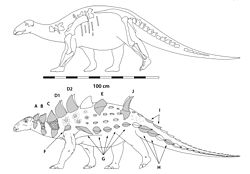Struthiosaurus
|
Struthiosaurus Temporal range: Late Cretaceous, 85–66 Ma |
|
|---|---|
 |
|
| Diagrams showing the known skeletal elements and hypothetical placement of osteoderms in S. austriacus | |
| Scientific classification | |
| Kingdom: | Animalia |
| Phylum: | Chordata |
| Class: | Reptilia |
| Clade: | Dinosauria |
| Order: | †Ornithischia |
| Family: | †Nodosauridae |
| Subfamily: | †Struthiosaurinae |
| Genus: |
†Struthiosaurus Bunzel, 1871 |
| Type species | |
|
†Struthiosaurus austriacus Bunzel, 1871 |
|
| Species | |
| Synonyms | |
|
|
Struthiosaurus (Latin struthio = ostrich + Greek sauros = lizard) is one of the smallest known and most basal genera of nodosaurid dinosaurs, from the Late Cretaceous period (Campanian-Maastrichtian) of Austria, Romania and France in Europe. It was protected by body armour. Although estimates of its length vary, it may have been as small as 2.2 metres (7.2 ft) long.
In 1859, geologist Eduard Suess at the Gute Hoffnung coal mine at Muthmannsdorf near Wiener Neustadt in Austria, discovered a dinosaur tooth on a stone pile. With the help of mine intendant Pawlowitsch it was attempted to find the source of the fossil material. The search proved fruitless at first but ultimately a thin marl layer was discovered, intersected by a obliquely sloping mine shaft, which contained an abundant number of various bones. These were subsequently excavated by Suess and Ferdinand Stoliczka. The marl was a fresh water deposit.
The finds were stored in the museum of the University of Vienna but received little attention until they were studied by Emanuel Bunzel in 1870. In 1871, Bunzel published a treatise describing the fossils and naming several new genera and species. One of them was the genus Struthiosaurus based on a single partial portion of the posterior end of the skull, largely consisting of the braincase. The type and only known species of the genus at the time was Struthiosaurus austriacus. Bunzel stated that he only provisionally named the taxon and gave no etymology of the name. The generic name is derived from Neolatin struthio, itself derived from Ancient Greek στρούθειος, stroutheios, "of the ostrich". Bunzel chose the name because of the birdlike morphology of the braincase. The specific name refers to the provenance from Austria.
...
Wikipedia
